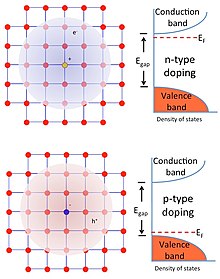
A | B | C | D | E | F | G | H | CH | I | J | K | L | M | N | O | P | Q | R | S | T | U | V | W | X | Y | Z | 0 | 1 | 2 | 3 | 4 | 5 | 6 | 7 | 8 | 9

Modulation doping is a technique for fabricating semiconductors such that the free charge carriers are spatially separated from the donors. Because this eliminates scattering from the donors, modulation-doped semiconductors have very high carrier mobilities.
History
Modulation doping was conceived in Bell Labs in 1977 following a conversation between Horst Störmer and Ray Dingle,[1] and implemented shortly afterwards by Arthur Gossard. In 1977, Störmer and Dan Tsui used a modulation-doped wafer to discover the fractional quantum Hall effect.
Implementation
Modulation-doped semiconductor crystals are commonly grown by epitaxy to allow successive layers of different semiconductor species to be deposited. One common structure uses a layer of AlGaAs deposited over GaAs, with Si n-type donors in the AlGaAs.[2]
Applications
Field effect transistors
Modulation-doped transistors can reach high electrical mobilities and therefore fast operation.[3] A modulation-doped field-effect transistor is known as a MODFET.[4]
Low-temperature electronics
One advantage of modulation doping is that the charge carriers cannot become trapped on the donors even at the lowest temperatures. For this reason, modulation-doped heterostructures allow electronics operating at cryogenic temperatures.
Quantum computing
Modulation-doped two-dimensional electron gases can be gated to create quantum dots. Electrons trapped in these dots can then be operated as quantum bits.[5]
References
- ^ Horst L. Störmer, Nobel Biography
- ^ Gossard, A. C. (1985). "Modulation Doping of Semiconductor Heterostructures". Molecular Beam Epitaxy and Heterostructures. pp. 499–531. doi:10.1007/978-94-009-5073-3_14. ISBN 978-94-010-8744-5.
- ^ L.D. Nguyen; L.E. Larson; U.K. Mishra (2009). "Ultra-high speed modulation-doped field-effect transistors: a tutorial review". Proc. IEEE. 80 (4): 494. doi:10.1109/5.135374.
- ^ Global Standards for the Microelectronics Industry - modulation-doped field-effect transistor (MODFET)
- ^ R. Hanson, L. P. Kouwenhoven, J. R. Petta, S. Tarucha, and L. M. K. Vandersypen (2009). "Spins in few-electron quantum dots". Rev. Mod. Phys. 79 (2): 1217. arXiv:cond-mat/0610433. Bibcode:2007RvMP...79.1217H. doi:10.1103/RevModPhys.79.1217. S2CID 9107975.
{{cite journal}}: CS1 maint: multiple names: authors list (link)
Text je dostupný za podmienok Creative Commons Attribution/Share-Alike License 3.0 Unported; prípadne za ďalších podmienok. Podrobnejšie informácie nájdete na stránke Podmienky použitia.
Antropológia
Aplikované vedy
Bibliometria
Dejiny vedy
Encyklopédie
Filozofia vedy
Forenzné vedy
Humanitné vedy
Knižničná veda
Kryogenika
Kryptológia
Kulturológia
Literárna veda
Medzidisciplinárne oblasti
Metódy kvantitatívnej analýzy
Metavedy
Metodika
Text je dostupný za podmienok Creative
Commons Attribution/Share-Alike License 3.0 Unported; prípadne za ďalších
podmienok.
Podrobnejšie informácie nájdete na stránke Podmienky
použitia.
www.astronomia.sk | www.biologia.sk | www.botanika.sk | www.dejiny.sk | www.economy.sk | www.elektrotechnika.sk | www.estetika.sk | www.farmakologia.sk | www.filozofia.sk | Fyzika | www.futurologia.sk | www.genetika.sk | www.chemia.sk | www.lingvistika.sk | www.politologia.sk | www.psychologia.sk | www.sexuologia.sk | www.sociologia.sk | www.veda.sk I www.zoologia.sk
